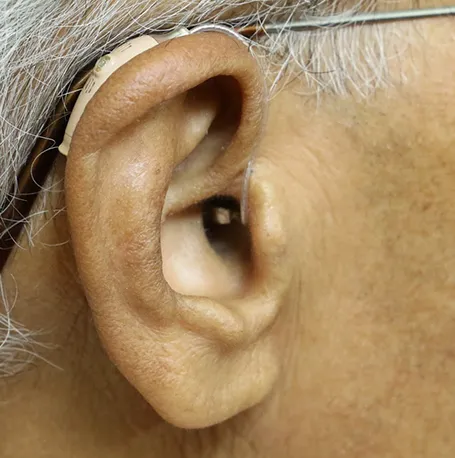Advanced Hearing Aid Technology
TYPES OF HEARING AIDS
In The Ear (ITE) Hearing Aids
These advanced hearing aids are worn in the ear and, hence, are custom-made, using the measurements of the ear taken by us at the time of consultation. This advanced hearing aid technology comes in half shell designs that cover half the bowl of the outer ear as well as fill almost the entire outer bowl. The size makes it optimal for people with low dexterity, and it also accommodates additional features like volume control and program buttons.
They are available in the following styles:
Advanced Hearing Aid: Invisible In the Canal (IIC)
This is the tiniest hearing aid made, and is fitted deeply in the ear canal. Due to the small size, it does not have manual controls like volume or program buttons. It is practically invisible when worn. Due to the positioning, it is prone to damage caused by ear wax and moisture.
Advanced Hearing Aid: Completely In the Canal
Very similar to Invisible In The Canal, this Invisible hearing aid is also fitted inside the ear canal and is practically invisible when worn. Devoid of any manual controls and being tiny in size, it is recommended for people with high dexterity, and mild or moderate hearing loss.
Advanced Hearing Aid: In The Canal (ITC)
This hearing aid is worn in the lower portion of the outer ear and is slightly larger than the IIC and CIC. It is suitable for a wide range of hearing loss and has a longer battery life as well. Due to its bigger size, it accommodates volume controls and directional microphones.

Pros of ITEs
- Are easier to handle
- Easy to camouflage in the ear
- Light in weight and custom moulded to fit inside the ear canal
- Have several rechargeable battery options for a longer battery life
- Are designed with a superior ability to pick up on high-frequency sounds
- Their position inside the ear canal makes telephone calls and headset use easy
- Less likely to pick up on wind noise because of the protection from the outer ear
- Need less power to transmit sound and are less likely to produce a whistling sound
- Have a volume control feature that usually doesn’t fit on smaller style hearing aids
Cons of ITEs
- Controls are harder to see and feel
- Work well only for mild to moderate hearing losses
- Aren’t suitable for those with vision or dexterity issues
- Aren’t a good fit for everybody because of their small size
- Batteries can be tricky to replace because of the small size
- The smaller size of batteries can’t hold power for longer durations
- Don’t fit in the ear canals of the ones with a differently-shaped ear
- Not enough room for directional microphones for hearing in background noise
Behind The Ear (BTE) Advanced Hearing Aid Technology
These advanced hearing aids are worn behind or on top of the ear, along with a thin tube that sends the sound into the ear canal. The earmould or ear-tip for this is custom-made, to ensure they do not block the entire ear canal.

They are available in the following styles:
Mini BTE
This hearing aid is designed to sit behind the outer ear, while a thin tube directs sound into the ear from the tip. It is recommended for mild to moderate high frequency hearing loss. Due to its design, it allows for natural airflow, while the sound enters the ear from the tip.
Receiver In the Canal (RIC)
With this advanced hearing aid technology, the speaker is directly built into the ear tip, without being attached to the hearing aid body. It is connected by a thin wire to the microphone and processor that sit behind the ear. In case of any malfunction due to ear wax or moisture, the ear tip can be easily replaced at our hearing aid centre itself.
BTE with Earmould
This hearing aid can be designed to fit all types of hearing loss, from mild to profound. Due to the longer shape, it accommodates more features for volume control, program control, and power, than any other style of hearing aid. This is custom-made earmould and is less prone to damage caused by ear wax and moisture. It is commonly recommended for children, as the earmould can be replaced as the child grows and can be reprogrammed as required.
Pros of ITEs
- Easier to clean and maintain
- Are fully inserted into your ear canal just like a Bluetooth headset
- Usually, the most affordable hearing aids that suit almost every budget
- No trouble opening the battery case or cleaning all the nooks and crannies
- Users can see better amplification because of the batteries being big in size
- Nice and compact, they’re designed to make for an extremely comfortable fit
- They have the most powerful battery like among all kinds of hearing aids available
- Have more room for additional features like multi settings and directional microphones
- Provide more space for bigger batteries that keep hearing aids charged for longer durations
Cons of ITEs
- The tubing needs to be replaced quite often to ensure sustenance
- More likely to experience external noises when worn in open spaces
- Require a higher degree of upkeep as moulds need to be replaced every 2 years
- Are more visible and not suitable for someone looking for a more discreet option
- These hearing aids tend to have reduced sound quality as compared to ITEs or ITCs
- BTEs won’t let you conceal the fact that you’re wearing hearing aids (in case you wish to)
- Ear tubes and tips of the open fit micro BTEs need to be changed periodically for proper maintenance
